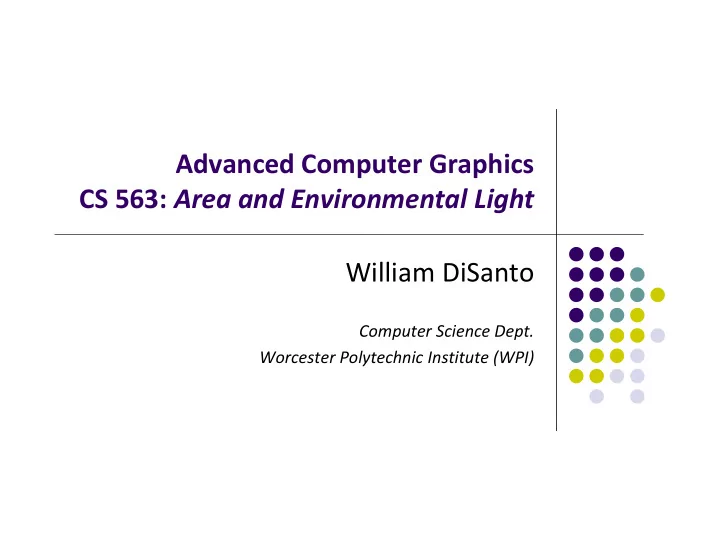

Advanced Computer Graphics CS 563: Area and Environmental Light William DiSanto Computer Science Dept. Worcester Polytechnic Institute (WPI)
Outline Radiometry Area Light Source Approximation Ambient Light Environmental Mapping Maps Explicit Spherical Harmonics Irradiance Map
Radiometry Radiance: Irradiance: Radiance [1]
Area Light Source Approximation: Model the area light as point or directional For any or all area sources compute a single vector e This vector represents the average magnitude and direction Irradiance can now be computed as Light Vector [1]
Area Light Source: Alternatives Easy to add color to the light vector model Wrapping: point light ‐ > light that covers hemisphere Implicit expression for a spherical area light Assuming constant radiance
Ambiance Outgoing radiance take a simple constant term Could replace with ambient reflectance for view dependent, self occluding ambiance
Environmental Mapping Model reflective surfaces Project reflect vectors onto some function Use function evaluation as radiance Environment Map [1]
EM: Maps Use components of reflect vector to sample: Equirectangular: Two singularities at poles, does not preserve area Mercator Equal Area [5]: [6] Other Maps: [5] [7] [5]
EM: Sphere Mapping Use light probe or generate data in View Dependent, recomputed for different view Transform surface normal and view vector into reference frame of sphere map projection [8]
EM: Cubic Environment Mapping View independent Better uniformity in sampling [1] Use isocube to achieve better distribution [9]
EM: Parabolic Mapping Join two parabolic projections No singularities Decent sampling Difficult to generate [10]
EM: Glossy Reflections Artifacts from sampling cube map [11] Filter with Gaussian lobes at various resolutions Not accurate but gives appearance of variable reflectivity [1] [11]
EM: Irradiance Mapping Map irradiance to some texture Generated from EM Addressed by the normal of surface Generate Irradiance Map [1] [12]
Spherical Harmonics: Impetus SH expression can allow for a reasonably accurate representation of low frequency objects. Fast to compute, small set of polynomials Reasonably fast to solve Allow for frequency domain modification Functions are orthonormal
Spherical Harmonics : Description Laplacian (divergence of gradient) expression. Provides a frequency domain representation of some feature in spherical coordinates. We look for where this expression is 0. We will fit solutions to zeros of the second derivative (essentially edge detection).
Spherical Harmonics: Expression Two parts of the equation: Zonal (perturbed only in the altitude angle [0..PI]) Legendre Polynomial Azimuthal (oscillates with altitude and azimuth) More components as frequency increases. Associated Legendre Polynomial Real and imaginary components are identical but out of phase
Spherical Harmonics: Intuition As order index m approaches degree l, oscillations concentrate in theta angle Left to Right: Degree 20, Order 10, 15, 20
Spherical Harmonics: Intuition When m index is close to l, oscillations concentrate in phi angle Left to Right: Degree 20, Order 10, 5, 0
Spherical Harmonics : Graphic * Modified from original to fit page [2]
Spherical Harmonics: Limitations Requires many components to represent non ‐ axially symmetric data Cannot represent all object perfectly, singularities require infinite terms Is not necessarily rotation invariant however its power spectrum is rotation invariant
Spherical Harmonics: Solutions Fit SH with least squares or some other method Build matrix of observed energy per Build matrix of basis functions constructed from associated Legendre polynomials Use some fitting method to find function weights Easy to generate with MATLAB, Mathematica, Boost libraries etc. Some methods can solve in [4]
EM: Inexpensive Irradiance Weighted sum of ground and sky radiance [3] Ambient cube (x,y,z) irradiance selected from cube map surfaces within the hemisphere of surface normal
References [1] Real Time Rendering: Third Edition by [2] Michael Kazhdan , Thomas Funkhouser , Szymon Rusinkiewicz, Rotation invariant spherical harmonic representation of 3D shape descriptors, Proceedings of the 2003 Eurographics/ACM SIGGRAPH symposium on Geometry processing, June 23 ‐ 25, 2003, Aachen, Germany [3] Steven Parker , William Martin , Peter ‐ Pike J. Sloan , Peter Shirley , Brian Smits , Charles Hansen, Interactive ray tracing, Proceedings of the 1999 symposium on Interactive 3D graphics, p.119 ‐ 126, April 26 ‐ 29, 1999, Atlanta, Georgia, United States [4] Rokhlin, V. and Tygert, M., Fast algorithms for spherical harmonic expansions, SIAM J. Sci. Comp. 27 (2005), 1903 ‐ 1928. [5]http://mathworld.wolfram.com/SinusoidalProjection.html [6]http://earthobservatory.nasa.gov/Features/BlueMarble/
References [7]http://www.westnet.com/~crywalt/unfold.html [8]http://gl.ict.usc.edu/HDRShop/tutorial/tutorial5.html [9] Wan, L., Wong, T. ‐ T., and Leung, C. ‐ S. (2007). Isocube: Exploiting the Cubemap Hardware. IEEE Transactions on Visualization and Computer Graphics, 13(4):720–731. [10] Wolfgang Heidrich , Hans ‐ Peter Seidel, Realistic, hardware ‐ accelerated shading and lighting, Proceedings of the 26th annual conference on Computer graphics and interactive techniques, p.171 ‐ 178, July 1999 [11]http://developer.amd.com/archive/gpu/ cubemapgen/pages/default.aspx [12]http://http.developer.nvidia.com/GPUGems2/gpugems2_chapter10.h tml http://www.mathworks.com/products/matlab/demos.html?file=/product s/demos/shipping/matlab/spharm2.html
Recommend
More recommend